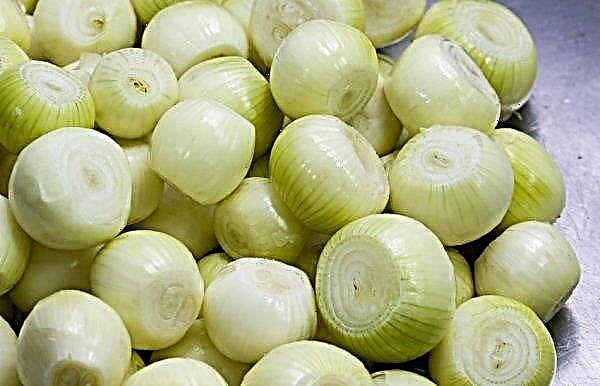Many homeowners pay particular attention to landscape design. Its main detail and decoration are garden paths, which not only serve as decor, but also greatly simplify movement in the garden, as well as zoning the space. When choosing a material, most dwell on stone - this natural material has high strength and long life. An additional advantage is the possibility of independent paving - this approach allows you to give the plot of the cottage an exclusive appearance, as well as realize the creative potential of the builder.
Pros and cons of different materials
Today, there is a huge selection of materials, the origin of which can be both natural and artificial. Each of them has its own advantages and disadvantages, which should be familiarized with before the final choice.
Did you know? According to Feng Shui teachings, garden paths carry the main vital energy of Qi, which means that their route should be winding and smooth, which will allow it to be evenly distributed throughout the site.
Natural stones
Among the wide range of natural stone, which can even confuse an inexperienced builder, the most popular are:
- slate - rock stones, in the composition of which are located parallel mineral intergrowths;
- granite - is a magmatic rock consisting of quartz, plagioclase, mica and potassium spar;
- shungite (also called "adobe stone") - a rock that can be found in black, brown or dark gray;
- sandstone - a stone consisting of clastic sedimentary grains, ranging in size from 0.5 to 2 mm, interconnected by mineral substances;
- quartzite - strong rock, consisting mainly of quartz and known for the difficulty of processing;
- cobblestone - natural stone of small size and rounded shape;
- pebbles - fragments of natural stones that have gone through various degrees of rolling.

- Despite the different characteristics, natural stone has common advantages over artificial stone:
- high decorative qualities;
- wide choose;
- ease of laying, which makes it easy to do on their own when paving paths;
- long period of operation (more than 300 years);
- high rates of heat resistance and frost resistance.
- The use of natural stone carries some disadvantages:
- high cost of material;
- the need to use special vehicles for transporting stone (due to its massiveness);
- compilation of at least a small project with sketches and calculations.
Artificial materials
The building materials market also offers a huge selection of various artificial materials, among which are usually used:
- paving slabs;
- concrete;
- paving stones;
- porcelain tiles and others.

Among the advantages of using such materials, they note their low, compared to natural, cost, simplicity and speed of installation, a wide range, as well as the ability to create an exclusive decoration. The main disadvantages are the need to install a drainage system in regions with unstable climatic conditions (for example, frequent heavy rains), as well as a short service life.
Necessary materials and tools
In addition to the selected base material for the tracks, you may additionally need:
- cement;
- water;
- gravel;
- sand.
The list of tools is not wide; it can be found at almost any summer resident or owner of a country house. The kit should consist of:
- bayonet and shovel shovels that will be required in the process of working with the soil;
- rubber mallet;
- a level that determines deviations from the correct position of individual stones;
- grinders equipped with special nozzles for working on stone;
- brushes for cleaning the remains of building material and garbage;
- shrink machine;
- ropes and stakes for marking;
- tanks for mixing cement.
Creating a plan and layout
Laying work should begin by creating a plan on which the plot and buildings will be laid on it, as well as the location of future paths. The next step will be marking. It is carried out by driving stakes around the perimeter and connecting them with a strong thread or rope. This approach will ensure that high accuracy is maintained during paving.
There are several basic recommendations that must be followed at this stage of the work:
- The path of the paths should not go close to the trees, as their strong and developed root system can cause significant damage to the base.
- The selected track width should not exceed 1–1.2 m.
- It is better to choose a form as simple as possible, since bends require a large amount of time to trim the material. In the case of working with natural stone, this will take a lot of energy.
- When creating a slope, precipitation must be taken into account (usually, at least 10 mm per 1 m is required).

Step-by-step instructions for creating a track
High-quality laying of garden paths includes several stages of execution, including the creation of a drainage layer and preparation of the base. Their following is necessary to maximize the life of the tracks, as well as their ability to withstand various loads.
Drainage structure
Due to heavy rainfall, water can significantly wash out the base, which will lead to a lot of problems. In order to avoid this, it is recommended to start laying with the creation of a drainage layer.
Important! Today, there are more modern solutions for laying the drainage layer, one of which is the use of a special drainage membrane. Additionally, it is initially equipped with a layer of geotextiles.
The procedure is not difficult:
- The marking removes the topsoil. In this case, the depth of the resulting trench should be at least 30 cm.
- Next, the bottom is carefully leveled and covered with a layer of sand about 10 cm thick, after which they are well compacted. This stage will reduce the likelihood of weeds.
- This is followed by a layer of fine gravel (about 5 mm), its thickness can vary from 10 to 15 cm.
- As a last step, the entire layer of crushed stone is covered with non-woven textiles.

Installation of borders
Borders allow you to give garden paths a clear outline, indicating their boundaries. And therefore, despite the somewhat troublesome procedure for installing them, many decide on this step.
The scheme is as follows:
- Markup. First of all, they select a place and determine the height of future borders. Then, the rope is pulled along the entire length taking into account the height, while in order to maintain strong tension the stakes are driven every 2-3 m. It should also be taken into account that in the case when the height of the curbs exceeds the track itself, it is necessary to take care of a slight slope to drain the water to avoid her stagnation.
- Digging a trench. Depth is calculated taking into account the height of the curb to the stretched thread and the thickness of the cement pad, on which the stone will be planted for greater reliability. When choosing the width, the size of the side stone is taken into account, and 1 cm is also added on each side for the convenience of work.
- Fill the base. Spend to strengthen the curb with the help of beacons, which can be used as improvised means such as wooden blocks 15 cm in length and 3 cm in thickness and tools (rules). They are laid at the bottom of the trench, for the entire length of the rule, after which they are poured with a mixture consisting of 1 part cement and 3 parts sand. Then level the surface and remove the bars, filling the empty spaces with the remaining mixture.
- Direct installation. It is carried out by setting each element individually. An important aspect is the horizontal alignment of the curb stone, focusing on a tightly stretched rope, as well as vertically, controlling the process with a building level. You can use a rubber mallet to give a slightly slanting stone the correct position.
- Fixation. After installing several stones, they should be carefully fixed to avoid beveling under their own weight. To do this, put a little sand-cement mixture at the base (with small flat cakes, 5 cm from the bottom), which, as it were, glues the border to the pillow. Then, an angle of 45 ° is attached to the outer edge of the mass, which increases the area of the support.
- Ground leveling. To give aesthetics to the appearance of the curb, it is necessary to dig under the ground level. From the side of the path not yet tiled, the drainage layer will play this role.
Foundation preparation
The functional purpose of garden paths determines the choice of the type of base for them - it is it that will reduce the load on the subgrade and avoid beveling. So:
- stone paths intended for use exclusively in the summer season, it is enough to strengthen the sand base;
- paths that are operated year-round will require a cement-sand base;
- entry roads (as well as small parking areas) must be strengthened with a concrete base (in some cases reinforced with reinforcement).
Based on the selection, additional tools and materials may need to be taken into account in the initial calculations.
Stone laying process
Regardless of the chosen base, the technology of stone laying has a single execution principle. However, each method still has some distinctive features that should be familiarized with before starting work.
On a cement-sand base
This method, due to its high strength and ability to pass moisture, is considered universal, and the process of its implementation is not very difficult.
In order to make a cement-sand foundation, you will need:
- Prepare a sand-cement mixture (hertz), consisting of sifted sand and Portland cement of class M. The optimal ratio is 6: 1.
- Lay the prepared composition on the drainage layer, to a height of at least 3 cm.
- Tamp the mixture thoroughly.
- Next, they lay a stone and close the seams.

On concrete base
The process of preparing a concrete monolith is performed step by step:
- Prepare the ingredients. There are many ways to prepare a solution, but the classic recipe involves the use of cement, sand, gravel and water (1 part cement, 3 parts sand, 3 parts gravel, water to a liquid state).
- A sand cushion is formed with a height of about 3 cm.
- Since concrete does not allow moisture to pass through, an additional drainage system will be required, consisting of pipes whose length is regulated by the height of the base. Laying is carried out from the calculation - 1 piece of pipe / 1 m².
- Create a formwork that will limit the spread of concrete mortar. In this role, wooden sides can be made, set around the perimeter.
- The following is a layer of prepared solution. Its height should be 8–10 cm. If reinforcement is used, the layer will increase by 4–5 cm.
Important! In the event that a border was previously installed, additional formwork will not be required. It is he who will act as a limiter for the spreading of the solution.
The time it takes for the concrete to dry completely is about 72 hours. Keep in mind that the quality of the solution directly affects the life of the paved paths, and therefore, it is necessary to pay special attention to the selection of the main ingredients:
- sand must be washed, dry, with medium sized particles (too large will reduce the plasticity of concrete, and too small - its strength, due to the absorption of a large amount of water);
- crushed stone - clean and fine;
- for cement Preferred are high grades such as M400 or M500 (you can determine “by eye” - the darker the powder, the higher the grade).

On a sand pillow
This technology is extremely simple. The sand is simply sprinkled with an even layer about 10 cm thick over the entire surface prepared for stone coating. In order to facilitate the tamping process, a small amount of water can be used to wet the bulk material.
Stitching
The procedure for sealing joints can begin one day after the installation of the stone coating of garden paths.
Did you know? If desired, garden paths can be made much brighter. For this, coloring pigment additives are added to the cement mortar, which allow you to get any color.
In total there are 3 ways to perform these works:
- sand;
- cement mortar;
- grouting solution.

In this case, if it is supposed to use a mixture of cement, it is recommended to carry out a preliminary primer on the surface of the coating, which will protect the stone from traces of work (it is quite difficult to remove the cement residues). Depending on the selected method, the process itself will slightly change. So, when using sand, you should not only select the desired fraction (0.2 mm is considered optimal), but also sift it first in order to get rid of possible roots, seeds of various plants and other things.
Further, the termination technology consists of three main steps:
- Sand is poured onto the surface, and then rubbed using a hard brush.
- Water the seams with water and wait for its shrinkage.
- Repeat the whole procedure again (sand is poured, rubbed, watered).

In the case of using a cement-sand mortar, the seams are closed with a trowel or rubber spatula and the remaining mixture is removed from the stone immediately after the procedure. In areas around the house, you should definitely use the cement grout method. This option will provide high durability to the coating, and also prevent leaching of joints.
Despite the rapid development of technology, which resulted in the emergence of a large number of new artificial materials, most homeowners often continue to choose natural stone. This is understandable: along with the possibility of laying it with your own hands, as well as a long period of operation, a beautiful pattern and a unique natural shade of stone is not able to repeat even the most modern synthetic material.











